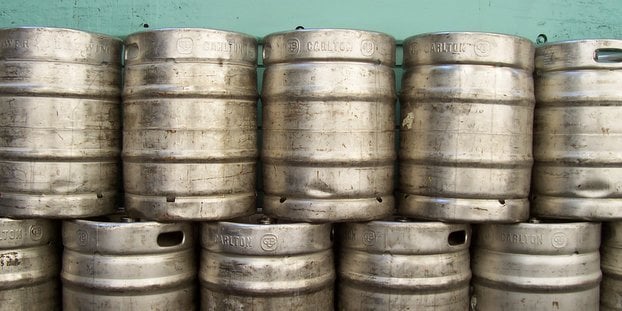
The main policy disincentive that effects craft beer production and sales is the restriction that strong beer cannot be sold alongside 3.2 percent beers in gas stations, markets or grocery stores. This policy has relegated craft beer sales to restaurants, bars, brewpubs and other locations that allow on-premise consumption. In my survey of Oklahoma brewers, companies indicated that an average of 63.6 percent of all production is sold to restaurants and bars, and 36.4 percent is sold to liquor stores.
It is beyond the scope of this report to discuss the societal impact that Oklahoma alcohol laws have in terms of mortality, vehicle incidents or substitution to other inebriants (among other potential societal impacts). A note covering recent economic research on the subject, though, may aid policy makers and the public when discussing the above mentioned policies. Fernandez, et al. (2016) find that dry counties have a higher percentage of meth lab seizures, and that states could reduce meth lab seizures by up to 30 percent if all counties were “wet” (also discussed in The Economist, October 2015, cited below).
In the Journal of Health Economics, Baughman, et al. (2001) study Texas county-level data to discuss variance in vehicle accidents. The authors find that, “the sale of alcohol, especially beer and wine, appears to have a negligible if not negative effect on the number of alcohol-related accidents. Second, the sale of higher alcohol-content liquor may present a greater risk to highway safety than the sale of beer and wine” (Baughman, et al. 2001).
Economic impact
This sections reports on the economic impact of the OKCB. Included in this section is (i) a summary of direct and indirect effects from the craft brewing industry as calculated by the Brewer’s Association, (ii) a national comparison of the OKCB industry with other similar-sized states, (iii) a discussion of potential growth paths for the craft brewing industry and what such an increase would amount to in terms of economic impact, (iv) a breakdown of the tax revenues that the OKCB industry is responsible for (v) and a forecast of tax revenues under various industry growth prospects.
Total impact, employment and wages
The Oklahoma craft brewing industry is quite small relative to the rest of the United States. In 2014, there were a total 10 craft breweries in operation. This small amount of companies ranked the state 47th among the other 50 states and Washington, D.C. Total production in Oklahoma amounted to 25,425 bbls of craft beer. This ranked 43rd in the country. On a per capita (drinking-aged adult) basis, though, Oklahoma again ranks 47th nationally. Despite the relatively small industry size, the OKCB had an economic impact of $415.7 million in 2014. This impact ranks Oklahoma 33rd nationally.
The $415.7 million economic impact of the OKCB industry is attributable to a number of factors that can be considered as “direct effects” or “indirect effects.” The direct effect of the craft brewing industry comes from the amount paid to employees within the craft brewing industry. Total income for Oklahoma craft brewers in 2014 amounted to $128.3 million, which accounts for 30.8 percent of the total economic impact. This means that the average pay per employee in 2014 was $49,870. This compensation ranks sixth nationally, only behind New York, Washington, D.C., Alaska, Minnesota and New Jersey. The average income of OKCB employees is thus higher than employees in California, Pennsylvania and Texas, which have well-cultivated craft brewing industries. This compensation also compares well with the state-wide GDP per capita of $41,871 or the nation-wide GDP per capita of $49,469.
RELATED: Six employment law tips for growing craft breweries
The remaining 69.2 percent of the $415.7 million economic impact is attributable to indirect effects like tax revenue and employment in other sectors along the supply chain. Supply chain employment includes agricultural jobs (grains, hops, etc.), wholesale distributor jobs, glass bottle production and restaurant, bar and liquor store employment. For example, indirect effects can be seen in the sale of craft beer at venues like Bleu Garten in Oklahoma City or The Patriarch in Edmond. At these locations, and others like them, food trucks from across the state are able to generate income for themselves and their suppliers, which include local farmers and artisans, advertisers and gasoline distributors among others. This gain in income has a reverberating effect throughout the economy as each individual spends their income at other locations pursuing other types of consumption. This is commonly referred to as the multiplier effect. In total, the OKCB contributed more than $288 million in extra economic activity in 2014.
Comparative economic impact
One way to gauge the relative success of the OKCB industry is to compare the economic impact of the industry with the impact in states of a similar population size. Using a sub-sample helps to reduce bias that is due to the sheer market size that a particular state’s craft brewing industry is able to sell to and helps to contextualize the output and impact of the OKCB industry. For this purpose, I chose states in a window of approximately 1 million people to Oklahoma’s population, 3.8 million. Table 1, below, shows the sub-sample of states and their populations along with the economic impact of the craft brewing industry in each state. Within the 13 sub-sample states, Oklahoma ranks 9th in terms of economic impact despite being the 6th largest state by population.
Table 1. Sub-sample states. Ordered by descending population
| State | Population | EI Rank | Economic Impact | ||||
| Alabama | 4,849,377 | 8 | $ 437,633,000 | ||||
| South Carolina | 4,832,482 | 7 | $ 443,241,000 | ||||
| Louisiana | 4,649,676 | 2 | $ 645,510,000 | ||||
| Kentucky | 4,413,457 | 5 | $ 495,103,000 | ||||
| Oregon | 3,970,239 | 1 | $ 1,837,356,000 | ||||
| Oklahoma | 3,878,051 | 9 | $ 415,776,000 | ||||
| Connecticut | 3,596,677 | 4 | $ 568,787,000 | ||||
| Iowa | 3,107,126 | 3 | $ 636,096,000 | ||||
| Mississippi | 2,994,079 | 13 | $ 222,614,000 | ||||
| Arkansas | 2,966,369 | 13 | $ 323,795,000 | ||||
| Utah | 2,942,902 | 12 | $ 389,908,000 | ||||
| Kansas | 2,904,021 | 11 | $ 415,776,000 | ||||
| Nevada | 2,839,098 | 6 | $ 480,128,000 |
Within the sub-sample, Oklahoma ranks ninth for total economic impact above only Kansas, Utah, Arkansas and Mississippi. Within this sample, Oregon immediately jumps out as having an enormous economic impact relative to the other states. Excluding Oregon, the average impact of the craft brewing industry in each state is $456.2 million. This puts Oregon’s impact at nearly four times the amount of any other state. Notice that Oklahoma is very similar in population to Oregon. The enormous economic impact seen in Oregon is due to the size of the Oregon craft beer industry, which employs nearly six times as many people and produces nearly 15 times as many barrels of craft beer. In Oregon, any craft beer that is below 14 percent ABV may be sold in grocery stores, gas stations and markets, and brewers of all sizes have self-distribution rights. Clearly, the laws governing Oregon craft beer consumption and production are much less restrictive than in Oklahoma. We can see that Oklahoma’s craft brewing potential impact given less restrictive laws is substantial.
The average production in 2014 for all sub-sample states was 141,199 bbls. The average craft beer production for the sub-sample excluding Oregon is 66,377. Table 2, below, shows the production total for each state in 2014.
Table 2. Total Production
| State | Barrels of Craft Beer | |
| Oregon | 1,039,063 | |
| Louisiana | 197,853 | |
| Utah | 161,606 | |
| Connecticut | 72,682 | |
| Kentucky | 71,640 | |
| South Carolina | 56,261 | |
| Nevada | 52,684 | |
| Iowa | 43,310 | |
| Alabama | 39,452 | |
| Kansas | 36,248 | |
| Oklahoma | 25,425 | |
| Mississippi | 24,725 | |
| Arkansas | 14,641 |
Table 2 shows that Oklahoma produced a small amount of craft beer relative to the other sub-sample states. Even after excluding Oregon, the Oklahoma craft brewing industry clearly produces well below the amount other states produced (average of 63,777). If current state alcohol laws were changed to allow for refrigerated craft beer distribution in grocery stores, gas stations and markets (as in other states), this production amount would surely increase considerably.
On a per-barrel basis, however, the Oklahoma craft brewing industry compares well to the rest of the sub-sample. Table 3, below, shows the amount of economic activity that is attributable to each barrel of craft beer.
Table 3. Economic Impact (EI) per barrel
| State | Impact per Barrel | Impact per Glass | ||
| Arkansas | $ 22,115.63 | $ 89.18 | ||
| Oklahoma | $ 16,353.04 | $ 65.94 | ||
| Iowa | $ 14,687.05 | $ 59.22 | ||
| Kansas | $ 11,470.32 | $ 46.25 | ||
| Alabama | $ 11,092.80 | $ 44.73 | ||
| Nevada | $ 9,113.36 | $ 36.75 | ||
| Mississippi | $ 9,003.60 | $ 36.30 | ||
| South Carolina | $ 7,878.30 | $ 31.70 | ||
| Connecticut | $ 7,825.69 | $ 31.56 | ||
| Kentucky | $ 6,910.99 | $ 27.87 | ||
| Louisiana | $ 3,262.57 | $ 13.16 | ||
| Utah |
$ 2,412.71 |
$ 9.73 | ||
| Oregon | $ 1,768.28 | $ 7.13 |
Each barrel of craft beer in Oklahoma generated $16,353 worth of economic activity. To put this in context, each 12-ounce pour of craft beer sold in Oklahoma generated an economic impact of $65.94. Within the sub-sample, Oklahoma is second among the states with only Arkansas receiving more per barrel. This table also shows that while each additional barrel of craft beer generates more economic activity on the whole, the amount that each barrel contributes to economic activity gets smaller and smaller as production increases. Hence, there is a limit to the amount that the craft brewing industry could generate in additional economic impact. This feature is accounted for in the regression model presented next that explores how much the economic impact in Oklahoma will change if the craft brewing industry was to mature and produce more craft beer.





Oklahoma’s craft brewing economic impact report 2016 https://t.co/BOiqoIHQU6 via @craftbrewingbiz
Great article on Oklahoma’s craft brewing economic impact https://t.co/j7qHExH2pX via @craftbrewingbiz
Oklahoma’s craft brewing economic impact report 2016 https://t.co/Llm4zZBMnm via @craftbrewingbiz
#CraftBeer #CraftBrewing #Beer #BeerBiz The ultimate Oklahoma craft brewing economic impact report https://t.co/yz5rXyxQtj
RT @CraftBrewingBiz: Oklahoma’s craft brewing economic impact report, local laws are restricting growth @UCOBronchos https://t.co/EdC7mb29Pu